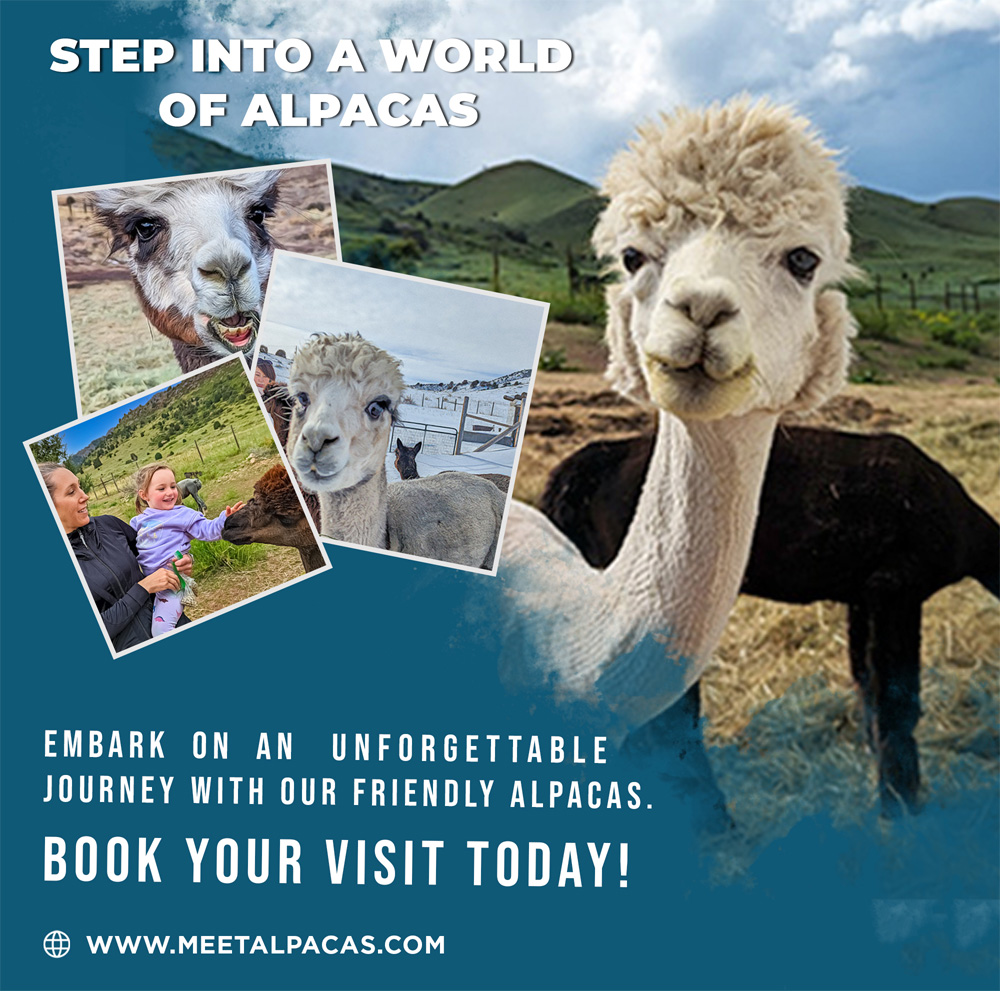Denver, Colorado alpaca experiences right now: Whether you’re looking for a new hobby or a career, alpaca farms provide a unique opportunity to explore your passions. You’ll be amazed at how rewarding it can be to care for these gorgeous creatures and the positive impact that they have on the people and land around them. Alpaca farms align with the growing global trend towards sustainability, and they offer a unique way to engage in ethical living. So, what are you waiting for? Check out an alpaca farm near you today! Find extra details on where to see alpacas in Colorado.

Keeping alpacas comfortable is essential, so you’ll want to ensure that their indoor living spaces are well-ventilated. They need to be able to stay cool in the summer, as sustained heat and humidity can lead to dehydration and other problems. You’ll also need to make sure they have access to clean water throughout the year. You might provide a water misting fan, use water coolers in the barn, or have a pond or kiddie pool for them to bathe in when needed. These simple things help to keep your alpacas healthy and happy.
Here’s why an alpaca experience is perfect for your upcoming trip to Denver. Alpacas are adorable, fluffy, and friendly animals. People are often surprised by just how sociable they are and how much they enjoy human affection. They are also incredibly calm creatures with steady temperaments. This makes them perfect for the whole family. They don’t display erratic behavior, making them more predictable around children.
Alpaca fur is a very prized fiber for artisans and crafters. Alpaca fur is very soft and does not retain water. It is also very durable. According to National Geographic, alpaca fur is the second strongest animal fiber, after mohair. Alpacas come in 22 colors, from a true, blue-black through browns and tans to white, according to Alpaca Ventures. Some Andean people eat alpaca meat. In Peru, it is often served in upscale restaurants. Alpacas don’t have teeth in the top-front of their mouths. This gives them the appearance of having an underbite.
Additionally, if you love seeing and interacting with animals, an alpaca farm provides a hands-on experience. You can hand-feed your new friends a healthy snack and hang out with them while they provide amusing entertainment. It provides you with the chance to interact with the ranch: Most people don’t know a lot about alpacas before they visit the ranch. Alpacas originate from South America, and they’ve been brought to Colorado over the last several decades. The climate of Colorado is perfect for the alpaca, so they’re content living on ranches in Denver. When you go behind the scenes on the ranch, you learn about much more than just the animals. You have the opportunity to talk about the economy, trade, production, local handmade goods, and so much more.
The alpaca comes in two breed types: huacaya (pronounced wuh-KAI-ya) and suri (SUR-ee). Huacayas, the more common type, account for about 85-90% of all alpacas. The two breed types vary primarily in terms of their fiber. How long do alpacas live? Generally, around 15 to 20 years. The longest documented lifespan of an alpaca is 28 years. How are alpacas different from llamas? People often confuse alpacas with llamas. While closely related, llamas and alpacas are very different animals. Llamas are much larger, about twice the size of an alpaca, with a weight range of 250 to 450 pounds. Alpacas weigh between 120 to 200 pounds. Llamas are primarily used for packing or for guarding herds of sheep or alpacas, whereas alpacas are primarily raised for their soft and luxurious fleece. Find additional info at https://meetalpacas.com/.
How much space does it take to raise an alpaca? Alpacas are environmentally friendly and require less pasture and food compared to other livestock. Stocking density impacts the health of the animal, so owners are encouraged to carefully assess their space. Vegetation, access to food and water, and shelter are some factors that influence the amount of space needed. Consult with your local agriculture authorities and breeders for specific recommendations for your area. Are alpacas clean animals? Yes, they are much cleaner than most livestock. Alpacas have a minimal aroma and tend to attract fewer flies in the summertime than other forms of livestock. Alpacas often defecate in communal dung piles. There may be three or four of these areas in a pasture. This makes for easy clean-up, reduced opportunity for parasites, and better overall hygiene in the herd.
What do alpacas eat? Alpacas mainly eat grass or hay. They consume approximately two pounds per 125 pounds of body weight or approximately 1.5% of the animal’s body weight daily in hay or fresh pasture. Grass hay is recommended, and alfalfa can be fed sparingly. Many owners feed higher rates of alfalfa to alpacas that are skinny, or live in very cold temperatures. Alpacas are pseudo-ruminants, with a single stomach divided into three compartments. They produce rumen and chew cud and are able to process this modest amount of food very efficiently. Many alpacas (especially pregnant and lactating females) will benefit from nutritional and mineral supplements, depending on local conditions. There are several manufactured alpaca and llama feeds and mineral mixes available. Consult with your local veterinarian to ensure you are providing an appropriate diet for your area. Alpacas also need access to plenty of fresh water to drink.
Alpacas are very social creatures. They are gentle and curious and with training can become great pets, according to Switzer. Herds often include animals of different species or taxonomic families, such as llamas, goats and sheep, according to the FAO. Alpacas spit when they are distressed or feel threatened. They will sometimes spit at each other when they are competing for food or trying to establish dominance, according to Switzer. They won’t spit at people or bite unless they have been abused.